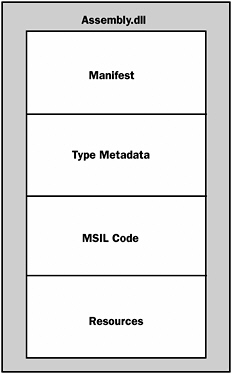Assemblies
The assembly is used by the CLR as the smallest unit for the following:
-
Deployment
-
Version control
-
Security
-
Type grouping
-
Code reuse
An assembly must contain a manifest, which tells the CLR what else is in the assembly. The other elements can be any of the following three categories:
-
Type metadata
-
Microsoft Intermediate Language (MSIL) code
-
Resources
An assembly can be just one file. Figure 21-1 details the contents of a single-file assembly.

Figure 21-1
Alternatively, the structure can be split across multiple files, as shown in Figure 21-2. This is just one example of a multiple-file assembly configuration.

Figure 21-2
An assembly can only have one manifest section across all the files that make up the assembly. There is nothing stopping you, however, from having a resource section (or any of the other sections of type Metadata and MSIL code) in each of the files that make up an assembly.
EAN: 2147483647
Pages: 267